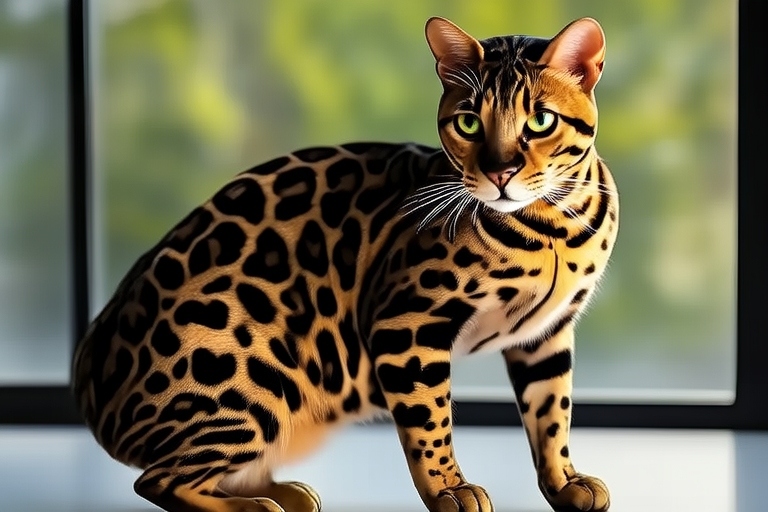The Exotic Enigma: Raising a Bengal Cat at Home
Introduction
Bengal cats, with their striking appearance and wild ancestry, have captivated the hearts of many cat enthusiasts. Originating from crossbreeding domestic cats with Asian leopard cats, these felines offer a unique blend of wild charm and domestic affection. Their distinctive coat patterns, reminiscent of leopards, make them stand out in any household. This article delves into the world of Bengal cats, exploring their unique characteristics, care requirements, and the joys of raising one of these exotic companions.
Physical Traits and Temperament
Bengal cats are medium to large-sized animals, known for their muscular build and athletic grace. Their most notable feature is their coat, which can be either spotted or marbled, often with a metallic sheen that adds to their allure. These cats possess a high level of energy and agility, making them excellent climbers and jumpers. Their temperament is generally friendly and playful, with a strong desire to engage with their human companions. Bengals are known for their intelligence and curiosity, often displaying behaviors more akin to dogs than typical house cats.
Why are they considered exotic? Their wild heritage contributes significantly to their exotic status. While they are fully domesticated, their lineage gives them a unique appearance and behavior that sets them apart from other breeds. Their striking coat patterns and active nature make them a standout choice for those looking for something extraordinary in their pet.
Detailed Care Instructions
Diet
Bengal cats require a balanced diet rich in protein and essential nutrients. High-quality commercial cat foods designed for active breeds are ideal, but it’s also beneficial to incorporate some raw meat into their meals occasionally. Always ensure fresh water is available at all times. Bengals are known for their hearty appetites, so monitoring portion sizes is crucial to prevent obesity.
Exercise
Given their high energy levels, Bengals need ample opportunities for physical activity. Interactive toys, climbing structures, and play sessions are essential to keep them entertained and healthy. Regular playtime helps maintain their muscle tone and prevents boredom, which can lead to destructive behaviors.
Grooming
Bengals have short, dense coats that require minimal grooming. However, regular brushing can help remove loose hair and prevent matting. Their luxurious fur can sometimes trap allergens, so vacuuming regularly and using air purifiers can reduce potential allergen buildup. Bathing is generally unnecessary unless absolutely required, as their natural oils are beneficial for their skin.
Health Considerations
While generally robust, Bengal cats are prone to certain health issues. Regular veterinary check-ups are vital to monitor their overall health. Common concerns include heart murmurs, hip dysplasia, and certain genetic conditions. Early detection and management of these issues can greatly improve their quality of life.
Suitable Living Environment
Space Requirements
Bengal cats thrive in environments that offer plenty of space for exploration and activity. Multi-level homes with access to high perches and vertical spaces are ideal. They enjoy being able to climb and observe their surroundings from various vantage points. Ensure there are safe areas for them to rest and retreat when needed.
Safety Measures
To safeguard your Bengal, secure windows and balconies to prevent accidental falls. Use childproof locks on cabinets containing hazardous substances. Providing safe, sturdy scratching posts can redirect their natural scratching behavior away from furniture. Regularly check for toxic plants and ensure any electrical cords are safely secured.
Behavioral Issues and Training Techniques
Bengal cats are intelligent and can sometimes display challenging behaviors if not properly engaged. Common issues include excessive vocalization, chewing on inappropriate items, and territorial marking. Positive reinforcement training methods, such as clicker training, can be highly effective. Rewarding desired behaviors with treats and praise encourages repetition, while consistently ignoring unwanted behaviors helps diminish them over time.
Conclusion
Owning a Bengal cat is a rewarding experience filled with joy and companionship. Their unique appearance, playful nature, and strong bond with humans make them cherished members of many households. For potential owners, it’s important to understand the commitment involved in providing proper care and attention. With the right environment, training, and love, Bengal cats can bring immense happiness and excitement into your home. Embrace the exotic enigma and welcome a Bengal into your family today.
Tips for potential owners:
- Research extensively about Bengal cats before committing to ownership.
- Prepare your home adequately to meet their needs and ensure their safety.
- Be patient and consistent with training to address any behavioral challenges.
- Regularly consult with veterinarians to maintain their health and well-being.
